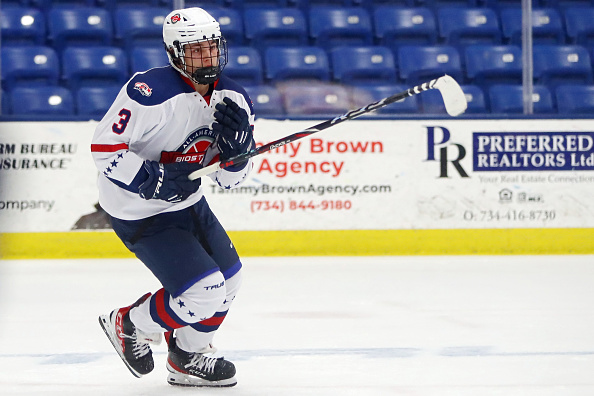Isaac Howard is one of many US National Team Development Program players making waves this year. Being consistently ranked within the first-round, Howard is very much a high-upside prospect. However, he’s been hidden behind some high-end teammates. Some of those teammates include Logan Cooley and Seamus Casey. So what does Howard bring?
Isaac Howard Scouting Report
Howard, born in Hudson, Wisconsin, on March 30th, 2004, is a 17-year-old forward playing with the USNTDP. Standing at 5’10” and 183 pounds, Howard primarily plays left wing. In the 2020-21 season, Howard joined the USNTDP, with 27 goals and 27 assists for 54 points in 34 games with the under-17 team. That strong U17 performance led to a 17 game stint with the U18’s that season, where he scored five goals and 14 assists for 19 points in 17 games.
So far this season, Howard has 23 goals and 31 assists for 54 points in 41 games. That performance this season has led to his draft rankings being in the mid-first and early-second-round range. He has been ranked 10th by Dobber Prospects, 14th by The Puck Authority, 15th by Bob McKenzie, 17th by SportsNet, 21st by Craig Button, 25th by Draft Prospects Hockey, 27th by FCHockey, 30th by Smaht Scouting, 31st McKeen’s Hockey, 32nd by Elite Prospects, and 34th by Recruit Scouting. This writer has Howard ranked 21st in the class.
Isaac Howard deep dive
Being projected just about anywhere in the first round, and even early second round, tells fans that he is a top-end prospect. But the large range set by analysts and sites suggests that Howard has the skills needed, but may be missing something. What does he bring to the table, and why does he have such a large range to be selected in?
Howard’s skating weaknesses are coach-able
Isaac Howard isn’t the best skater, but he certainly is not bad. His top-end speed could use some work, as he keeps up with the play but doesn’t have the ability to blow past defenders and win races with regularity. He also does not possess that extra gear to generate scoring chances consistently off the rush, like a Connor McDavid or Brayden Point can. Howard’s speed can certainly improve with a better first few steps. His acceleration is similar to his speed; it isn’t great, but it certainly isn’t bad. Improving on that will help build his straight line speed further.
Getting deeper into his skating mechanics, Howard could use a bit more work. His ankle flexion needs some work. That ankle flexion will improve when his knee bend is addressed. Howard doesn’t get low enough when he’s skating, which is ultimately the flaw in his technical abilities. Once he gets a lower center of gravity when skating, his knee and ankle flexion will be more consistent and ultimately improve. However, the biggest flaw in Howard’s skating is his edge work. Time and again, when watching Howard’s film, it’s easy to notice how he takes long, wide turns, where he loses speed. It can be frustrating at times, as when the play changes directions, Howard falls behind due to those wide and slow turns.
Offensive abilities
Offense is where Howard shows his best traits. It also displays that high-upside talked about earlier, while also displaying a reason why some scouts may be lower than others – Howard is, in this writer’s opinion, a boom-or-bust prospect. Howard is always pushing the pace, constantly forcing the play into the high-danger areas of the ice. Both his passing and shooting tendencies display just how often he looks to the high-danger areas to generate all of his offense.
Starting with his playmaking skills, as mentioned, Howard is full throttle. That’s not to say Howard can’t make the smart and simple passes, but he just would rather go for a high-risk, high-reward play first. Overall, Howard completed just 73.02% of his passes across three tracked games, while the average among 13 other tracked forwards is at 77.14%. His below-average completion percentage is attributed to his high volume of high-risk, high-reward passes, with 30.16% of his total offensive zone passing attempts aimed at high-danger (the average is 21.55%). Of that high volume, he’s completed just 31.58% of them (the average is 49.33%). Again, Howard is full throttle. It will be extremely difficult to translate that extremely fast pace to even the NCAA, let alone the NHL. But if Howard does translate that playmaking game, he could be lethal.
Isaac Howard’s shooting ability
As for Howard’s shot, this is his strength offensively. Howard has a quick and deceptive release, and a really good ability to adjust the release point of his shot to fool goaltenders. However, his shot does lack consistent power and accuracy. While it isn’t a big problem, he does need to fine tune his shooting efficiency. It starts with his mechanics. Josh Tessler nailed his break-down of Howard’s shot mechanics on his scouting report:
“Ultimately, when you look at his shot mechanics there are reasons why he struggles with accuracy. For instance, he needs to work on his weight transfer. On quite a few shots from range, Howard struggles to push his body over his knee for maximum power. Howard also needs to work on where his stickblade is in comparison to the net. If his stick blade aligns with the net, then he has a far better chance of getting a quality shot on net.”
Looking at the numbers, in three tracked games, Howard fired 24 total shots, with 50% of them hitting the net. Of those 24 shots, 54.17% of them were taken from high-danger, while the average is just 43.61%. He hit the net on 69.23% of his high-danger shots, with the average sitting at 81.71%. Again, like with his passes, he fires a high volume in high-danger, but is not as efficient as the average from those chances.
What do these numbers tell us about Isaac Howard?
Howard is an uber-aggressive and extremely high-paced forward that, if he can translate to the next level, can be a lethal forward. He’s comparable to a sports car that can hit high speeds quickly. But even those beautiful cars have breaks, and if the driver does not use said breaks when it’s needed, the car won’t last very long. Howard needs to learn to hit the breaks on his fast-paced game, or his high speed (strength) will lead to his game crashing.
What the numbers don’t tell, however, is this writer’s favorite part about Howard’s offence: his off-puck ability. Howard has an incredible knack for finding open ice for himself and his teammates as a passing option when he doesn’t have possession. Consistently, when watching his film, he’s noticeably in the right spots consistently. That vision and IQ to read the defense and find those open spots will help him translate that high-end offense a little bit easier.
Isaac Howard’s transitional abilities
Isaac Howard’s transitional game is just like his skating; good, but not great. Howard’s zone exit game – leaving the defensive zone – is below average, which will be talked about shortly. Entering the offensive zone, however, is more important for a winger, and Howard is above average in that regard. Looking at zone exits first, Howard was involved directly in 15 zone exit attempts in the three tracked games. He successfully cleared the zone with possession on 60% of them (the average is 64.73%). And 26.67% of the exit attempts he carried out himself successfully. The average for successful zone exit carries is 36%.
When it comes to entering the zone, Howard was involved directly in 37 zone entry attempts. He gained the zone with possession on 70.27% of them (the average is 68%). Howard skated the puck in himself with success on 56.76% of his zone entry attempts. That posted above the average again (50%). Overall, Howard needs to work on his skating and stickhandling to further his efficiency in the neutral zone. His stickhandling is more of a consistency thing than a skill problem, which makes this area certainly coachable.
Defensive zone play
Now, part of Howard’s issues with zone exit efficiency is due to his defensive zone play. He cheats up ice a lot when his team first nets possession. That takes him out of the chance of generating a zone exit as he already left the zone, without the puck. Additionally, he does not involve himself very often in the defensive zone. Howard generally floats in the defensive zone. He does a nice job putting himself in the right spots, and he supports down low. However, he looks disengaged at times, and when he is engaged in the play, he gets caught chasing. If he can reel in his aggressiveness and implement his clearly strong vision, while maintaining his solid positioning, he could be average defensively.
What is Isaac Howard’s potential?
Howard is a high-upside forward, with a decent amount of risk. However, when drafting players, you draft based on where they will be in three or more seasons. Not what they are at 17 or 18 years old. That said, projecting Howard is difficult with his offensive, which may lead to teams shying away from him. However, as mentioned a few times, if Howard can translate his fast-paced style, while simultaneously understanding when to slow his game down, he could be a steal.
Howard has the upside to be a first-line winger in the future. However, if he doesn’t learn to reel in his aggressive offensive style, he’ll likely struggle to translate to the NHL level, if he’s even given the chance. That said, he may never see the NHL if things don’t work his way. That’s where the boom-or-bust nature of Howard arises. Despite that, the upside is tantalizing, and an NHL general manager should be happy to land a player like Howard. They just need to have the right plan to make sure Howard gets a solid opportunity.






